Rassia, Aikaterini-Iliana. "Neglected Evidence and New Discoveries in Greek Epigraphy: The Contribution of Stephanos A. Koumanoudes." CHS Research Bulletin 11 (2023). https://nrs.harvard.edu/URN-3:HLNC.ESSAY:103377756
Early Career Fellow in Hellenic Studies 2022-23
Introduction
Scattered inscriptions lying in ruins, whether found in their original archaeological setting or embedded within the walls of public buildings, houses, and in Orthodox churches or Muslim mosques, are preserved in the old notebooks of scholars who made a concerted effort to record, study and collect Greek inscriptions. It is easily forgotten, however, how deeply rooted the contribution of 19th-century scholars and travellers is in the rescue, preservation, and development of the first systematic study of Greek inscriptions. Even when we possess the complete narrative of an ancient historian, inscriptions recorded in archives are of great value in confirming or supplementing, or sometimes, clarifying the nuances of an ancient literary text. In this light, this research project focuses on the identification of the ancient inscriptions, as these are preserved in the archive of Stephanos A. Koumanoudes (1818-1899) in the National Library of Greece.
Systematic actions for rescuing Greek inscriptions
Stephanos A. Koumanoudes (1818-1899) was one of the most well-educated and prolific epigraphists of the 19th century (Fig.1) who published hundreds of Greek and Latin inscriptions. He served for forty years (1846-1886) as professor of Latin Philology at the University of Athens and secretary for thirty-five years (1859-1894) of the Archaeological Society at Athens. His contribution was decisive in the formation of the Society and its emergence as an internationally acclaimed academic institution. Koumanoudes was the editor of two peer-reviewed academic journals (Φιλίστωρ and Ἀθήναιον). He was also one of the founders of Ἀρχαιολογική ᾽Εφημερίς of the third period (1883), and through his academic editing and publications, elevated this journal into a prominent academic position (Πετράκος 2019, 83-84, 93-94, 111-112). His robust academic presence was not limited to the study of Antiquity. He was an eminent lexicographer, poet, literary critic, and emerged as a national scholar who had a decisive role in the intellectual constitution and formation of the modern Greek state (Ματθαίου, Σ. 1999, 80).
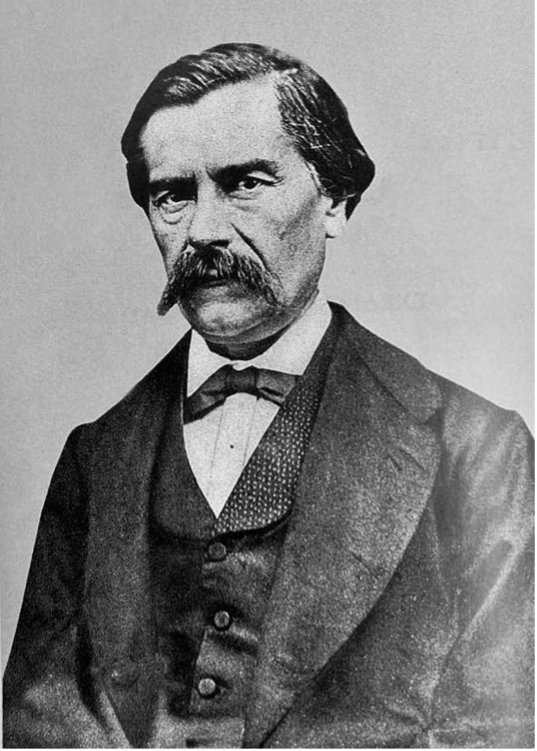
With his expertise, methodical mind, and enthusiasm he breathed new life into the organisation of the Archaeological Society at Athens in which he served as a General Secretary for 35 years (1859-1894). Under his initiative, large-scaleexcavations were carried out in Athens [the Asclepieion and the Stoa of Eumenes on the south slope of the Acropolis, Hadrian’s Library, the Roman Agora, the Kerameikos and Dipylon, the Theatre of Dionysus, the Olympieion and the Stoa of Attalos, elsewhere in Attica (Rhamnous, Marathon, Eleusis, the Amphiaraeion, Piraeus) in Boeotia (Chaironeia, Tanagra, Thespiai), and the Peloponnese (Mycenae, Epidauros, Lakonia). In many of those, such as the one at the Asclepieion he was the chief supervisor (Πετράκος 1987, 85, 264, 275-276; Πετράκος 2019, 101-102). Apart from the findings of the excavations, since 1859, he systematically purchased various archaeological finds, including inscriptions for preventing their illegal export (Πετράκος 1987, 54; Κόκκου 1997, 184).
In the Koumanoudes memoir Petrakos (1999, 21) remarked the following, “but the work, which he especially loved and to which he devoted his time, the work, through which his memory will remain forever cherished…is the collection and rescue of ancient monuments. Since he settled at Athens, he dedicated to this work…He was well-known to the local inhabitants of Athens, for everyone saw him walking with endless zeal around the city and the suburbs, entering yards and cellars, supervising the excavation of foundations, copying inscriptions, collecting sherds, and for all his care to rescue the few remains of antiquity.” Ιn 1860, the Archaeological Society at Athens published a book entitled Greek Inscriptions most of them Unpublished, the editor of which was Koumanoudes. It contains inscriptions, most of which come from Athens and Piraeus.
S. A. Koumanoudes’ epigraphic methodology
S.A. Koumanoudes was renowned for the swift and efficient publication of newly discovered inscriptions while his concise and insightful comments in the treatment of the epigraphic texts made him one of the most esteemed epigraphists of his time. As Spyros Basis, one of his students, and then Latin professor, remarked (Βάσης 1899, 417): “His intention was to publish as quickly as possible any important inscription that was discovered. Ιt was sufficient to him to accurately present the surviving letters of an inscription, and those that were unidentifiable due to the great weathering, and to complete what he, who was most experienced in this matter, could safely and readily complete, and to clarify the restorations by means of brief notes.” For his epigraphic methodology and publications was greatly praised by international scholars, who attributed him the honorary title of Altmeister of Greek epigraphy, which is equivalent to the title given to August Böckh (Βάσης 1899, 417). While, by contrast, he was called by his compatriots under the dubious designation of “Cerberus of Greek Epigraphy” (Ματθαίου Σ. 1994, 83).
He was fortunate to receive worldwide recognition both during his lifetime and posthumously. For instance, Adolf Wilhelm used to emphasise to his undergraduate students at the National University of Athens, that the preface of Koumanoudes’ monograph Ἀττικῆς Ἐπιγραφαὶ Ἐπιτύμβιοι (1871) is invaluable and unique for the study of Attic epigraphy, as it is the single most significant exposition of the application of epigraphic principles by any Greek epigraphist of the 19th century (Wilhelm 2005, 16).
More specifically, first and foremost, Koumanoudes in the preface of his volume, justifies the need to publish the epigraphic texts in miniscule letters. This choice is nothing more than the application of his belief that through this way more people would learn these monuments, and not only the rich, who were able to buy the critical editions of the inscriptions published in capital letters at that time (Κουμανούδης Σ.Α. 1862, 270-1; Κουμανούδης Σ.Ν.-Ματθαίου Α.Π. (1993) 476-478; Ματθαίου Σ. (1994) 82). Lastly, the volume of The Funerary Attic Inscriptions is significant for another important reason: “it is one of the earliest thematic corpora. In fact, it may well be the earliest. Earlier epigraphic corpora were collections of inscriptions from regions, museums, or excavations. Koumanoudes, however, appears to be the first epigraphist to have singled out a theme for independent research study, at least as concerns the discipline of Greek epigraphy” (Papazarkadas 2014, 407).
Neglected evidence and epigraphic discoveries of S. A. Koumanoudes
In the majority of modern publications, the first secure archaeological discovery of Kerameikos is an achievement of S.A.Koumanoudes that has gone into oblivion, except for a few exceptions (Πετράκος 2019, 99). It should be remarked here that he was right to predict that, the excavations conducted by the Archaeological Society around the church of Agia Triada (fig.2) would bring to light the Themistoclean city wall and the well-known Dipylon.
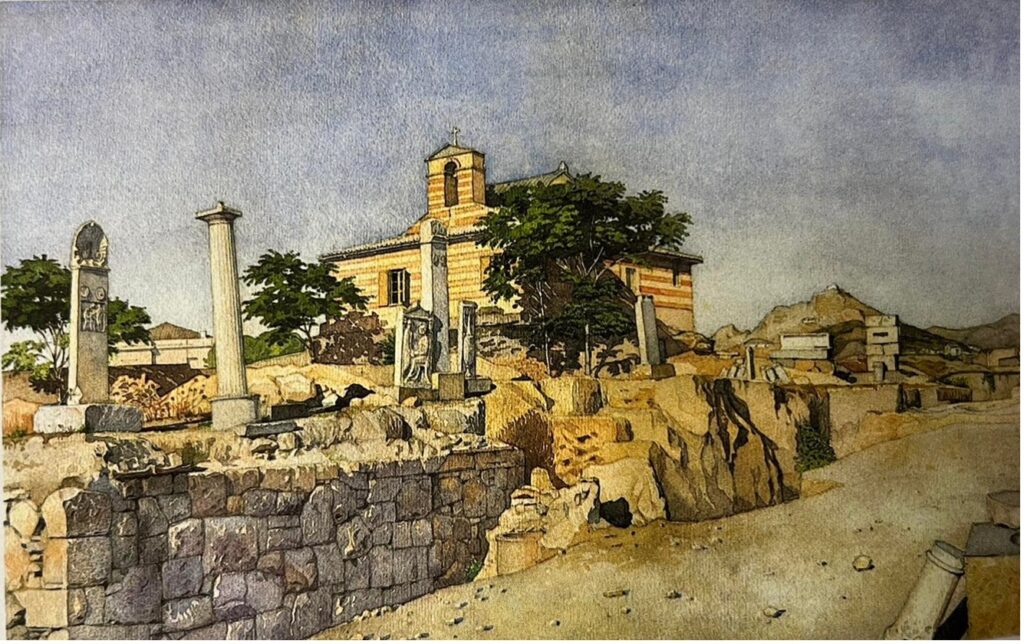
As a matter of fact, S.A.Koumanoudes was proven right, for in 1871, part of the Dipylon was found and the first boundary stone (Fig.3) bearing the inscription ΟΡΟΣ ΚΕΡΑΜΕΙΚΟΣ (IG II2 2617) was discovered westwards of the NW tower of Dipylon. The inscribed boundary stone dated to the mid-4th century BC was found standing upright above on a limestone base. Most significantly, it was found in situ and in contact with the wall. (Travlos 1971, 300; On the excavation of Kerameikos, see Πετράκος 1998, 117-172; Πετράκος 2019, 98-99).
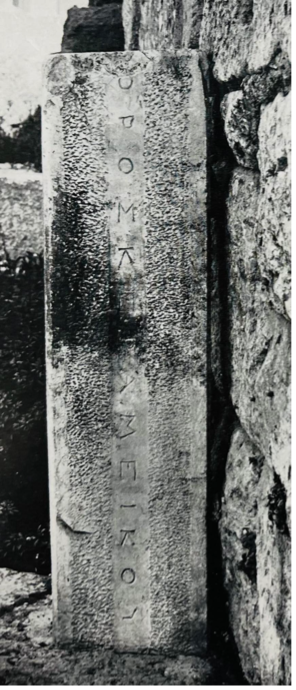
This significant archaeological finding (Fig.3) was important for the exact identification of the position of the Outer Kerameikos, “which is identified with the road leading to the Academy from the Dipylon and which seems to have had marble markers along its full length with the inscription “boundary stone of the Kerameikos”, like the one first discovered by S.A.Koumanoudes (Travlos 1971, 300). As we can see below, in his excavation report, Koumanoudes (1982, 9) stressed the importance of this finding and critiqued the archaeologists who placed here and there the Kerameikos without supporting their claims with solid archaeological evidence (Trans. Papazarkadas & Kingsley):
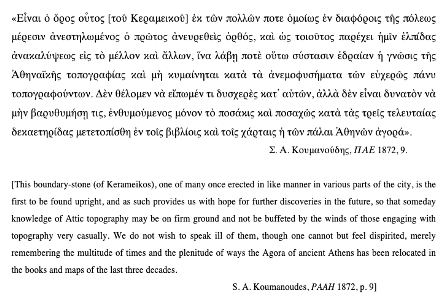
Another important aspect of his legacy to the contemporary Greek epigraphy is identified in the rich and very important archive of Koumanoudes, which is held in the National Library, covers the whole range of his research interests and activities. Over the years, researchers of the modern Greek history and literature have made extensive use of it. However, the same does not apply to Koumanoudes’ archival papers (τὰ χαρτία) on the inscriptions. Even though Koumanoudes had received universal recognition as an intellectual and academic scholarly figure, his archival epigraphic papers had not been given the attention they deserved and have not been the subject of research.
The Early career fellowship in Hellenic Studies at the Center for Hellenic Studies enabled me to study in depth the epigraphic archival papers of S.A.Koumanoudes at the National Library of Greece, which consist of copies of identified and unpublished inscriptions as well as squeezes (mainly his own, but also those sent to him by other, often old students). During my study, I realised how the epigraphic papers kept in his archive can be studied anew and often correlated with other sources and yield results of important historical and epigraphic value. To give an example, the starting point of a recent paper that I published in a recent paper entitled Rassia, Aikaterini- Iliana (2023) “An Unpublished Note of S. A. Koumanoudes on IG II2 2660”, Grammateion 12, 15-20 was the discovery of a neglected hand-written note of Stephanos A. Koumanoudes that preserves a different reading from the editio princeps of IG II2 2660 which was published in 1877 by Ulrich Köhler. This prompted me to undertake an autopsy of the inscription at the Epigraphic Museum (ΕΜ 10197). As the photograph of the stone vividly demonstrates, Koumanoudes’ corrected reading of line 6: θυγατρί is still visible (Fig.4). For this reason, I published a new edition of the inscription followed by a commentary in the pertinent paper.
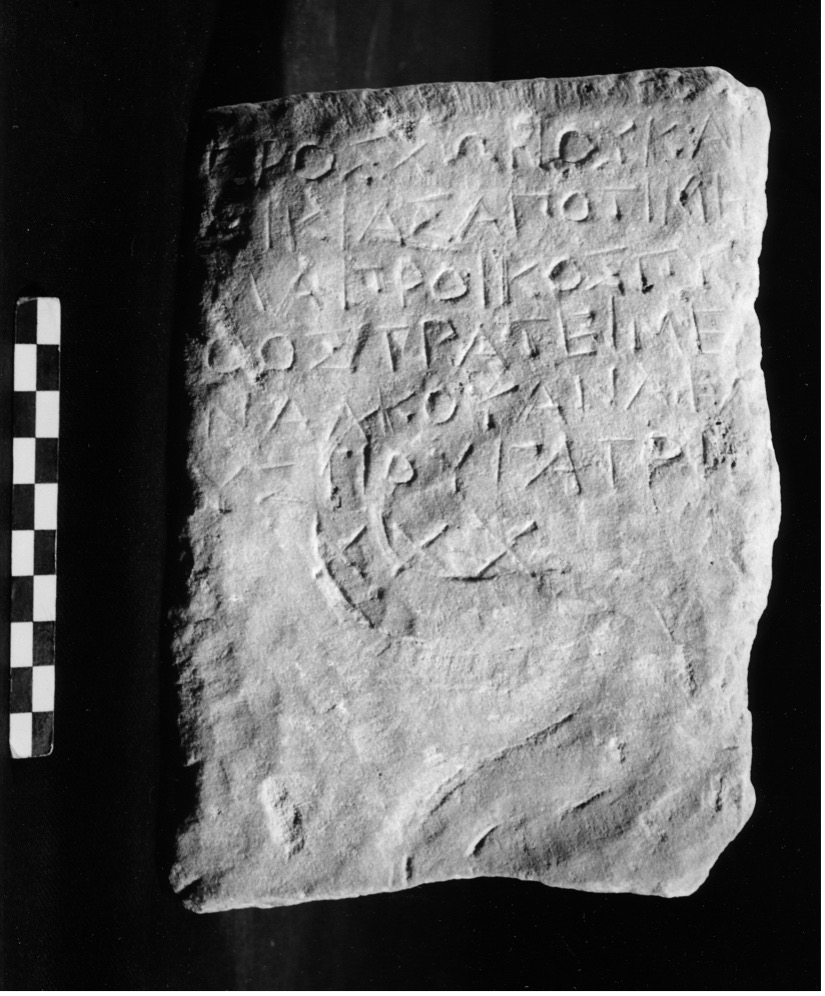
It is also evident in almost every epigraphic archival paper, that for Koumanoudes the recording of the provenance of an archaeological monument is of chief importance. The indivisibility of topography and epigraphy was implicit in his methodology. This was a consistent feature in his publications because he wanted to distinguish the provenance of an inscribed stone firmly and securely from the place of its later location (Κουμανούδης Σ.Ν. & Ματθαίου Α.Π. 1993, 475). This is also made clear in his transparent and forthright statement in the preface of his magnum opus (trans. Papazarkadas & Kingsley):
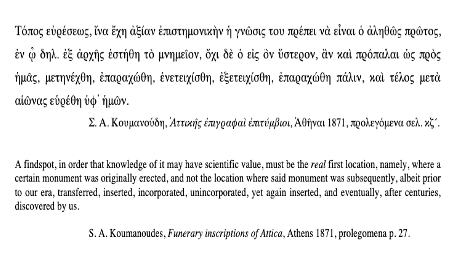
The CHS fellowship in Hellenic Studies allowed me to study in detail both his published and unpublished archival papers on Greek and Latin inscriptions kept in his archive at the Department of Manuscripts at the National Library of Greece. As part of communicating the ideas and findings of my CHS research project, an earlier version of the paper published in Grammateion Vol.12 (2023) had been presented at a residential meeting held at the Center for Hellenic Studies (Washington D.C.) in December 2022. I would like to thank both the non-residential and residential fellows for their comments. The next step of this project is the publication of the identified inscriptions in a monograph which has been accepted for publication in the series of the Greek Epigraphic Society.
Acknowledgements: For permission to publish the photograph of IG II2 2660, currently kept at the Epigraphic Museum (ΕΜ 10197), I am grateful to Elena Zavvou. While, Angelos P.Matthaiou offered invaluable bibliographical guidance. Finally, I would like to express my gratitude to the Director and the Selection Committee of the Center for Hellenic Studies for funding this project, the completion of which would not have been possible without their support.
Selected bibliography
Βάσης, Σ. (1899) “Σ.Α.Κουμανούδης”, Ἀθηνᾶ 11, 409-419.
Κόκκου Α. (1997) Η Μέριμνα για τις Αρχαιότητες στην Ελλάδα και τα Πρώτα Μουσεία, εκδόσεις Ερμής.
Κουμανούδης Σ.Α. (1862) Φιλίστωρ 2, 270-1.
Κουμανούδης, Σ. Α. (1871) Αττικής Επιγραφαὶ Ἐπιτύμβιοι, Ἀθῆναι.
Koυμανούδης, Σ.Α. (1872) Πρακτικά Αρχαιολογικής Εταιρείας 1872.
Κουμανούδης Σ.Ν.- Ματθαίου Α.Π. (1993) Στεφάνου Ἀθ. Κουμανούδη, Ἀττικῆς Ἐπιγραφαὶ Ἐπιτύμβιοι, Ἐν Ἀθήναις 1871[Ἀνατύπωσις καὶ Προσθῆκαι ἐκδιδόμεναι ὑπὸ Βιβλιοθήκη τῆς ἐν Ἀθήναις Ἀρχαιολογικῆς Ἐταιρείας.
Mατθαίου, Σ. (1999) Στέφανος Α. Κουμανούδης (1818-1899), Σχεδίασμα Βιογραφίας, Η εν Αθήναις Αρχαιολογική Εταιρεία.
Papazarkadas, N. (2014) “Epigraphy in Early Modern Greece”, Journal of the History of Collections vol.26, 399-412.
Πετράκος Β.Χ. (1987) H εν Aθήναις Aρχαιολογική Eταιρεία: H ιστορία των 150 χρόνων της, 1837-1987, Βιβλιοθήκη της εν Αθήναις Αρχαιολογικής Εταιρείας αρ.104.
Πετράκος Β.Χ. (1998) Μέντωρ 48, 117-172.
Πετράκος Β.Χ. (1999) Μέντωρ 49, 20-22.
Πετράκος Β.Χ. (2019) Ἡ ἐν Ἀθήναις Ἀρχαιολογικὴ Ἑταιρεία. Οἱ πρῶτες δεκαετίες. 1837-1909, Βιβλιοθήκη τῆς ἐν Ἀθήναις Άρχαιολογικῆς Ἑταιρείας (ΒΑΕ 321).
Travlos, J. (1971) Pictorial Dictionary of Ancient Athens, Praeger Publishers.
Wilhelm, Adolf (2005) Eισαγωγικά Περί Ελληνικών Επιγραφών, Ελληνική Επιγραφική Εταιρεία.
